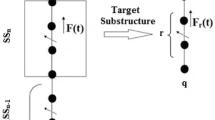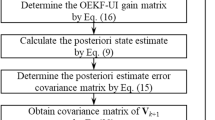Abstract
Electro-hydraulic control systems are nonlinear in nature and their mathematic models have unknown parameters. Existing research of modeling and identification of the electro-hydraulic control system is mainly based on theoretical state space model, and the parameters identification is hard due to its demand on internal states measurement. Moreover, there are also some hard-to-model nonlinearities in theoretical model, which needs to be overcome. Modeling and identification of the electro-hydraulic control system of an excavator arm based on block-oriented nonlinear(BONL) models is investigated. The nonlinear state space model of the system is built first, and field tests are carried out to reveal the nonlinear characteristics of the system. Based on the physic insight into the system, three BONL models are adopted to describe the highly nonlinear system. The Hammerstein model is composed of a two-segment polynomial nonlinearity followed by a linear dynamic subsystem. The Hammerstein-Wiener(H-W) model is represented by the Hammerstein model in cascade with another single polynomial nonlinearity. A novel Pseudo-Hammerstein-Wiener(P-H-W) model is developed by replacing the single polynomial of the H-W model by a non-smooth backlash function. The key term separation principle is applied to simplify the BONL models into linear-in-parameters structures. Then, a modified recursive least square algorithm(MRLSA) with iterative estimation of internal variables is developed to identify the all the parameters simultaneously. The identification results demonstrate that the BONL models with two-segment polynomial nonlinearities are able to capture the system behavior, and the P-H-W model has the best prediction accuracy. Comparison experiments show that the velocity prediction error of the P-H-W model is reduced by 14%, 30% and 75% to the H-W model, Hammerstein model, and extended auto-regressive (ARX) model, respectively. This research is helpful in controller design, system monitoring and diagnosis.
Similar content being viewed by others
References
GU J, SEWARD D. Digital servo control of a robotic excavator[J]. Chinese Journal of Mechanical Engineering, 2009, 22(2): 190–197
SEPEHRI N, LAWRENCE P D, SASSANI F, et al. Resolved-mode teleoperated control of heavy-duty hydraulic machines [J]. Journal of Dynamic Systems, Measurement, and Control, 1994, 116(2): 232–240.
QUANG N H. Robust low level control of robotic excavation[D]. Sydney: The University of Sydney, 2000.
ZIAEI K, SEPEHRI N. Modeling and identification of electrohydraulic servos[J]. Automatics, 2000(10): 761–772.
HE Q H, HAO P, ZHANG D Q. Modeling and parameter estimation for hydraulic system of excavator’s arm[J]. Journal of Central South University of Technology (English Edition), 2008, 15: 382–386.
SHAHRAM T. Identification of frictional effects and structural dynamics for improved control of hydraulic manipulators[D]. Vancouver: University of British Columbia, 1997.
LI B, YAN J, ZENG Y H, et al. Investigation of nonlinear dynamic characteristics for servo system of a hydraulic excavator arm[J]. China Mechanical Engineering, 2012, 23(15): 1 807–1 810. (in Chinese)
LI B, YAN J, GUO G, et al. Nonlinear modeling and analysis of electro-hydraulic proportional control system for excavator[J]. Mechanical Science and Technology for Aerospace Engineering, 2012, 31(9): 1 458–1 462. (in Chinese)
YAO B, BU F, REEDY J, et al. Adaptive robust motion control of single-rod hydraulic actuators: theory and experiments[J]. IEEE/ASME Transactions on Mechatronics, 2000, 5(1): 79–91.
GIRI F, BAI E W. Block-oriented nonlinear system identification [M]. Verlag Berlin Heidelberg: Springer, 2010.
KWAK B J, YAGLE A E, LEVITT J A. Nonlinear system identification of hydraulic actuator friction dynamics using a Hammerstein model[C]//Proceedings of the 1998 IEEE International Conference on Acoustics, Speech and Signal Processing, Seattle, WA, 1998.
YAN J, LI B, GUO G, et al. Parameter identification of servo system for excavator arm based on Hammerstein model[J]. Acta Armamentarii, 2012, 33(12): 1 527–1 532. (in Chinese)
VOROS J. Modeling and identification of systems with backlash[J]. Automatica, 2010, 46(2): 369–374.
BARREIRO A, BANOS A. Input-output stability of systems with backlash [J]. Automatica, 2006, 42: 1 017–1 024.
GU J, TAYLOR J, SEWARD D. Modelling of an hydraulic excavator using simplified refined instrumental variable(SRIV) algorithm[J]. Journal of Control Theory and Applications, 2007, 5(4): 391–396.
YAN J, LI B, TU Q Z, et al. Automatization of excavator and study of its autocontrol[C]//Proceedings of 3th International Conference on Measuring Technology and Mechatronics Automation, Shanghai, China, 2011: 604–609.
MERRITT H E. Hydraulic control system[M]. New York: John Wiley & Sons, 1967.
VOROS J. Iterative algorithm for parameter identification of Hammerstein systems with two-segment nonlinearities[J]. IEEE Transactions on Automatic Control, 1999, 44(11): 2 145–2 148.
VOROS J. Identification of nonlinear dynamic systems using extended Hammerstein and Wiener models[J]. Control Theory and Advanced Technology, 1995, 10(4), part 2: 1 203–1 212.
DONG R L, TAN Q Y, TAN Y H. Recursive identification algorithm for dynamic systems with output backlash and its convergence[J]. International Journal of Applied Mathematics and Computer Science, 2009, 19(4): 631–638.
VOROS J. An iterative method for Hammerstein-Wiener systems parameter identification[J]. Journal of Electrical Engineering, 2004, 55(11–12): 328–331.
Author information
Authors and Affiliations
Corresponding author
Additional information
This project is supported by National Natural Science Foundation of China(Grant No. 51175511)
YAN Jun, born in 1962, is currently a professor and a PhD candidate supervisor at College of Field Engineering, PLA University of Science and Technology, China. His main research interests include Mechatronics, Military Equipment management and maintenance.
LI Bo, born in 1985, is currently a PhD candidate at College of Field Engineering, PLA University of Science and Technology, China. He received his bachelor degree from Northeastern University, China, in 2008. His research direction is hydraulic control system and filed robotics. He has published over 20 papers.
GUO Gang, born in 1965, is currently an associate professor at College of Field Engineering, PLA University of Science and Technology, China. His research interests include mechachonics engineering and fault diagnosis.
ZENG Yonghua, born in 1977, is currently a lecturer at College of Field Engineering, PLA University of Science and Technology, China. His research interests include Military Equipment management and maintenance.
ZHANG Meijun, born in 1958, is currently an associate professor at College of Field Engineering, PLA University of Science and Technology, China. Her research interests include mechanical dynamic systems and fault diagnosis.
Rights and permissions
About this article
Cite this article
Yan, J., Li, B., Guo, G. et al. Nonlinear modeling and identification of the electro-hydraulic control system of an excavator arm using BONL model. Chin. J. Mech. Eng. 26, 1212–1221 (2013). https://doi.org/10.3901/CJME.2013.06.1212
Received:
Revised:
Accepted:
Published:
Issue Date:
DOI: https://doi.org/10.3901/CJME.2013.06.1212




